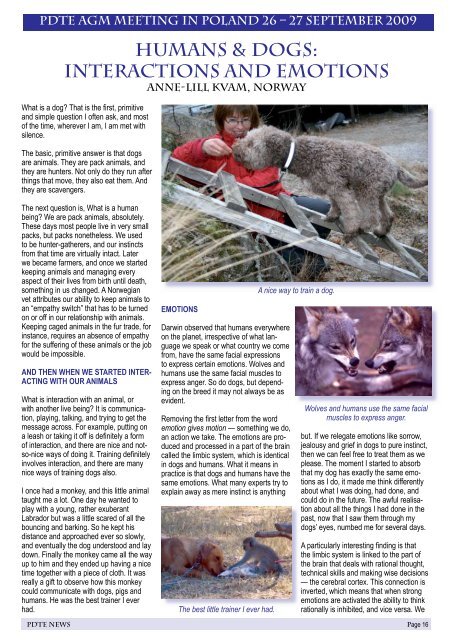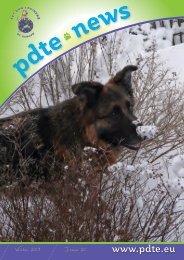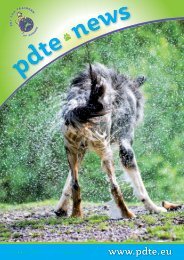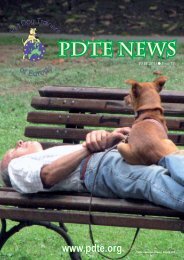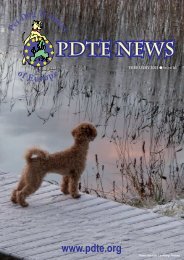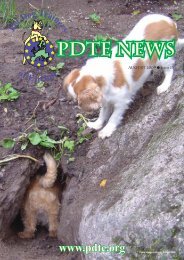PDTE 2010 January Newsletter
Create successful ePaper yourself
Turn your PDF publications into a flip-book with our unique Google optimized e-Paper software.
<strong>PDTE</strong> AGM MEETING In Poland 26 – 27 September 2009<br />
Humans & Dogs:<br />
Interactions and Emotions<br />
Anne-Lill Kvam, Norway<br />
What is a dog? That is the first, primitive<br />
and simple question I often ask, and most<br />
of the time, wherever I am, I am met with<br />
silence.<br />
The basic, primitive answer is that dogs<br />
are animals. They are pack animals, and<br />
they are hunters. Not only do they run after<br />
things that move, they also eat them. And<br />
they are scavengers.<br />
The next question is, What is a human<br />
being? We are pack animals, absolutely.<br />
These days most people live in very small<br />
packs, but packs nonetheless. We used<br />
to be hunter-gatherers, and our instincts<br />
from that time are virtually intact. Later<br />
we became farmers, and once we started<br />
keeping animals and managing every<br />
aspect of their lives from birth until death,<br />
something in us changed. A Norwegian<br />
vet attributes our ability to keep animals to<br />
an “empathy switch” that has to be turned<br />
on or off in our relationship with animals.<br />
Keeping caged animals in the fur trade, for<br />
instance, requires an absence of empathy<br />
for the suffering of these animals or the job<br />
would be impossible.<br />
AND THEN WHEN WE STARTED INTER-<br />
ACTING WITH OUR ANIMALS<br />
What is interaction with an animal, or<br />
with another live being? It is communication,<br />
playing, talking, and trying to get the<br />
message across. For example, putting on<br />
a leash or taking it off is definitely a form<br />
of interaction, and there are nice and notso-nice<br />
ways of doing it. Training definitely<br />
involves interaction, and there are many<br />
nice ways of training dogs also.<br />
I once had a monkey, and this little animal<br />
taught me a lot. One day he wanted to<br />
play with a young, rather exuberant<br />
Labrador but was a little scared of all the<br />
bouncing and barking. So he kept his<br />
distance and approached ever so slowly,<br />
and eventually the dog understood and lay<br />
down. Finally the monkey came all the way<br />
up to him and they ended up having a nice<br />
time together with a piece of cloth. It was<br />
really a gift to observe how this monkey<br />
could communicate with dogs, pigs and<br />
humans. He was the best trainer I ever<br />
had.<br />
EMOTIONS<br />
Darwin observed that humans everywhere<br />
on the planet, irrespective of what language<br />
we speak or what country we come<br />
from, have the same facial expressions<br />
to express certain emotions. Wolves and<br />
humans use the same facial muscles to<br />
express anger. So do dogs, but depending<br />
on the breed it may not always be as<br />
evident.<br />
Removing the first letter from the word<br />
emotion gives motion — something we do,<br />
an action we take. The emotions are produced<br />
and processed in a part of the brain<br />
called the limbic system, which is identical<br />
in dogs and humans. What it means in<br />
practice is that dogs and humans have the<br />
same emotions. What many experts try to<br />
explain away as mere instinct is anything<br />
The best little trainer I ever had.<br />
A nice way to train a dog.<br />
Wolves and humans use the same facial<br />
muscles to express anger.<br />
but. If we relegate emotions like sorrow,<br />
jealousy and grief in dogs to pure instinct,<br />
then we can feel free to treat them as we<br />
please. The moment I started to absorb<br />
that my dog has exactly the same emotions<br />
as I do, it made me think differently<br />
about what I was doing, had done, and<br />
could do in the future. The awful realisation<br />
about all the things I had done in the<br />
past, now that I saw them through my<br />
dogs’ eyes, numbed me for several days.<br />
A particularly interesting finding is that<br />
the limbic system is linked to the part of<br />
the brain that deals with rational thought,<br />
technical skills and making wise decisions<br />
— the cerebral cortex. This connection is<br />
inverted, which means that when strong<br />
emotions are activated the ability to think<br />
rationally is inhibited, and vice versa. We<br />
<strong>PDTE</strong> NEWS Page 16


